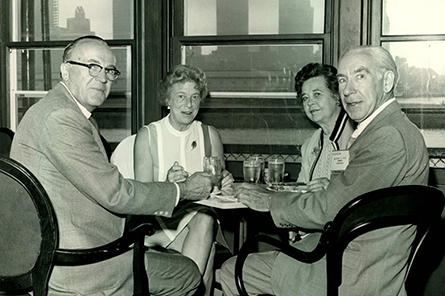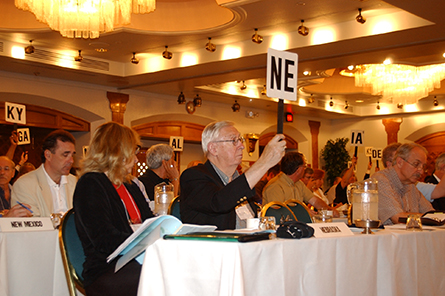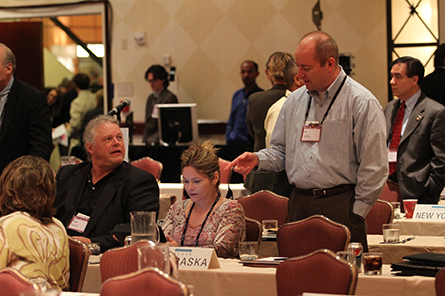Nebraska
Law Passed: 1937 • Joined NCARB: 1937 • Region 5—Central States (1965)
THE COMPONENTS OF LICENSURE
Education
1937: A degree from a four-year school approved by the board is equivalent to four years of experience. In 1972, the board added five-year schools to this requirement.
1972: The board also accepts degrees from five-year schools as equivalent to five years of experience.
1973: The board begins allowing graduates with non-architecture degrees to get licensed after six years of experience, updating to eight years in 1983. The 1980s bring about further board discussion over educational requirements, including NAAB-accreditation. Some members do not want to be bound to the NAAB system, and think the board could competently review each educational background.
1983: Individuals with no college education can become licensed with eight years of architectural experience.
1988: Any combination of years of education can be paired with experience to equal eight years. Applicants with no degree must complete 10 years of work experience as an alternative.
1997: A degree from a NAAB-accredited program is required.
Experience
1937: The original bill carries a “grandfather” clause individuals with 12 (or more) years of work in architecture, which remained until 1942. All other applicants must have either four years of experience and a four-year degree or eight years of experience.
1985: Applicants must complete the IDP.
Examination
1937: Applicants must pass an examination created by the board, designed to demonstrate architectural knowledge and skill.
1938: The exams are specified as the “Examination in the Fundamentals of Architecture” and the “Examination in the Professional Practice of Architecture.” Applicants taking the fundamentals exam would be tested on their knowledge of “statistics and dynamics, chemistry, mechanics, masonry, structural design, architectural history, orthographic projection, planning, supervising,” and several other skillsets.
1949: College graduates with certain grades do not have to take a fundamentals exam. Non-graduates are required to take the exam regardless of experience.
1959: Thirty-six hours of exams are required in seven categories, with a pass rate of 75 percent:
- History and Theory of Architecture
- Site Planning
- Architectural Design
- Building Construction
- Structural Design
- Professional Administration
- Building Equipment
1975: NCARB’s exam is introduced into Nebraska’s Rules for examinations.
1980: NCARB’s exam is removed from Nebraska’s Rules for examinations to avoid requiring rule changes with each exam update, despite protest from several architects.
1983: The ARE is required and re-introducted to Nebraska’s Rules.
Noteworthy
After false starts in 1913 and 1921, the board was officially created in 1937. On April 10, 1937, a joint executive meeting was held between the Nebraska AIA Chapter and the Nebraska Architects Association to elect three candidates for two open positions on the board, to be appointed by Governor Robert Cochran.
Charles Steinbaugh (president of the Nebraska Architects Association), William Steele (Nebraska AIA executive committee member) and Linus Burr Smith (Nebraska AIA president) were selected as the three nominees; Governor Cochran selected Steinbaugh and Steele as the first two architect board members.
The first meeting of the Nebraska State Board of Examiners for Professional Engineers and Architects was held May 25, 1937.
In addition to electing officers (Steele was unanimously elected secretary), the board voted to send Steinbaugh to NCARB’s annual meeting in Boston as an official representative of the Nebraska Board. The board members initially forgot to license themselves, and as a result later created their own license numbers: B-1 through B-5.
Several bills were unsuccessfully introduced between 1983 and 2009 intending to consolidate the board with other professions such as landscape architects, geologists, land surveyors, and interior designers. In 1984, the board underwent a Sunset Review, which eliminated architect-in-training provisions, increased fees for licensees, added accredited degrees as a licensure requirement, established a code of practice for architects, and added two ex officio education members to the board.
Another overhaul was passed in 1988, adding a public member and giving the education members voting privileges, as well as introducing continuing education requirements, creating emeritus status, enforcing rules and disciplinary action, and more. The new law also changed the name of the board to the Board of Engineers and Architects.
In 2017, all officers of the Nebraska Board were women for the first time. Public member Krista Kester was chair, engineer Jennifer Klein was vice chair, and architect Lenora Isom was Secretary.
NOTABLE PEOPLE
Members of the NCARB Board of Directors
1985-88: William M. Fenton (Lincoln)
2000-01: Melinda E. Pearson, FAIA (Lincoln)
First Chairman/President
1937-62: Roy M. Green (Lincoln)
First Board Members
1937-46: William Steele
1937-59: Charles Steinbaugh
1937-50: David Erickson
1937-62: Roy Green
1937-48: Albert Turner
First License Issued
1937: James C. Stitt (Norfolk)
First Woman Licensed
1970: Linda P. Arnold (Omaha)
First Woman Board Member
1994: Melinda Pearson, FAIA (Lincoln)
First Architectural Education Member (Non-Voting)
1983: Ernest O. Moore
First Architectural Education Member (Voting)
1996: David Cronrath
First Public Member
1998-08: William Tringe (Holdrege)
First Architectural Organization
1998: Hill Farrell Associates Inc. (Bellevue)
NCARB President Medalists
2008: Melinda Pearson, FAIA (Lincoln)


